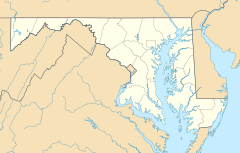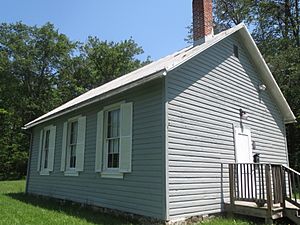Boyds, Maryland facts for kids
Quick facts for kids
Boyds, Maryland
|
|
|---|---|

Boyds, Maryland, seen from Maryland Route 117
|
|
| Country | |
| State | |
| County | |
| Population
(2020)
|
|
| • Total | 9,538 |
| Time zone | UTC-5 (Eastern (EST)) |
| • Summer (DST) | UTC-4 (EDT) |
| Zip code |
20841
|
| Area code(s) | 240 and 301 |
Boyds is a small community in the countryside of Montgomery County, Maryland, in the United States. It's located about 27 miles north of Washington, D.C.. The area's ZIP Code is 20841.
In 2020, the area covered by Boyds' ZIP Code was about 27 square miles. Around 9,538 people lived there. Boyds is also home to several fun outdoor spots. These include Black Hill Regional Park, Little Seneca Lake, and Seneca Creek State Park.
History of Boyds
The community of Boyds is named after Colonel James Alexander Boyd (1823–1896). He was an engineer from Scotland. Colonel Boyd worked on building the Baltimore and Ohio Railroad line.
Building the Railroad
After the American Civil War, Colonel Boyd built a temporary village. This village was for the workers who were building the railroad. The railroad line, called the Metropolitan Subdivision, started running in 1873.
Once the railroad station opened, more businesses came to Boyds. There was a mill, stores, and other shops. The Baltimore and Ohio Railroad built a brick station in 1887. This station was later taken down in 1927 to make room for a second train track. A new wooden station was built, but it was also removed later. Today, people can still take the Commuter Rail (called MARC) from Boyds to places like Washington, D.C..
James Boyd also started dairy farms in the area. He lived in Boyds until he passed away in 1896.
Boyds Negro School
The Boyds Negro School was a very important place. It was the only public school for African Americans in the area. It operated from 1896 to 1936. Today, the Boyds Negro School is a Maryland Historic Site. You can find it at 19510 White Ground Road.
The school was a small, one-room school house. Inside, it had desks, a blackboard, and a potbelly stove for heat. There was also a picture of the famous abolitionist Frederick Douglass. Students learned many subjects, including spelling, cooking, reading, singing, and weaving.
The Boyds Historical Society helped fix up the school in 1989. They added furniture to make it look like it did in the early 1900s. In 2006, the school needed more repairs because of termites. It reopened on June 28, 2008. This was part of Montgomery County's yearly heritage days.
Today, the Boyds Negro School is open to visitors. You can visit on the last Sunday of each month from April to October, between 2:00 PM and 4:00 PM. You can also visit by asking for an appointment.
Boyds Stores and Businesses
The first Boyds Country Store opened in 1873. This was the same year the railroad came to town. James E. Williams ran the store. It was a place where people could buy goods. It also became a meeting spot for the townspeople in the afternoons.
Colonel Boyd built a second store in 1895. This store had a general store and the post office on the first floor. On the second floor, there was a town hall and a dance hall. Over time, the town hall area got smaller as the building was used for other things. It was eventually taken down in the early 1940s.
In the evenings, families would gather on the front porch of the general store. Parents would talk while their children played outside. In 1946, Brice P. Selby bought the first country store at an auction. He was known for letting customers buy things on credit. This meant he didn't always make a lot of cash profit. However, Selby was known as a very kind and generous person.
A third store, called the Boyds Country Market, was built in 1933 by Will Williams. It is located on Barnesville Road. The first two Boyds Country Stores, the old town hall, and other old businesses were all removed as the area developed.
A small post office was inside the country store from the early 1930s until 1974. Then, it moved to a new building on Barnesville Road. The post office is still there today.




